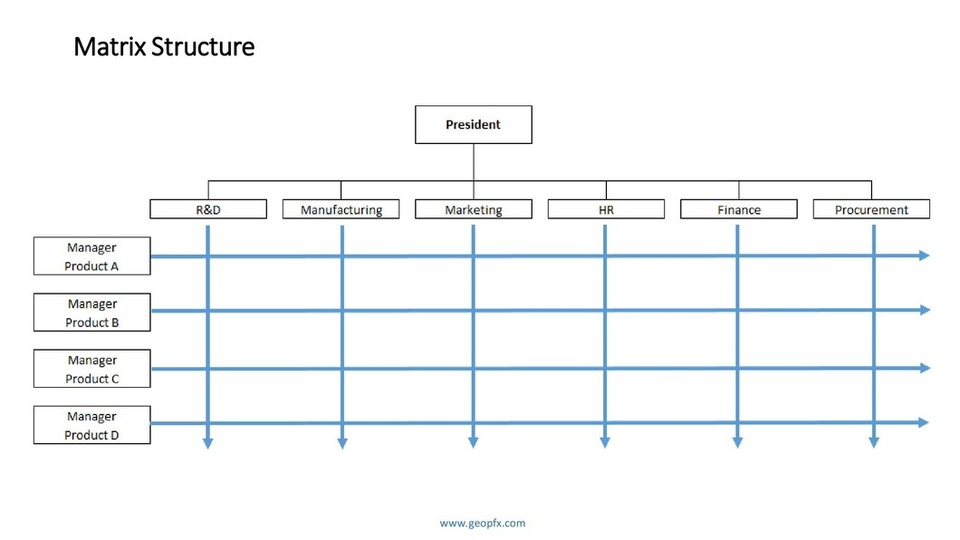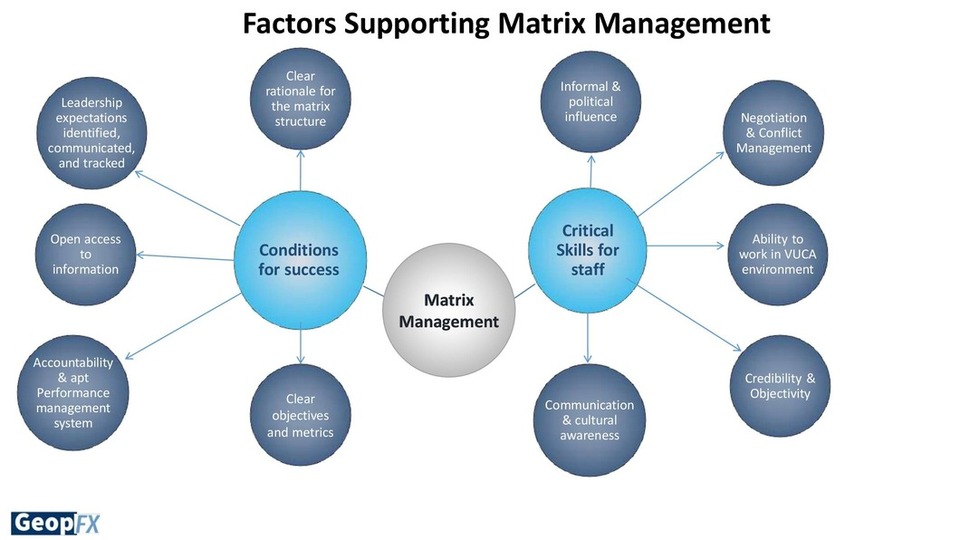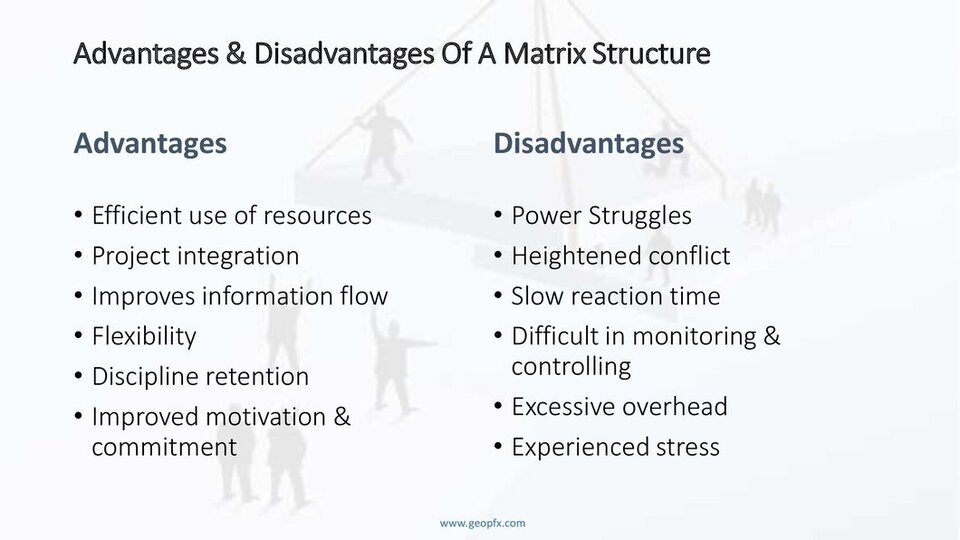What can you do to empower teams to move quickly on complex projects without relying on stakeholder approvals and reviews? Perhaps the solution lies in organizational structure. For everyone to understand who has the authority to make decisions, chains of command are typically in place at workplaces.
Normally, the CEO is at the top of a hierarchical organization chart. The COO and the CFO’s are right below them. From the top-level leadership roles, department managers spring forth, followed by project managers.
Team members in a matrix organization report to both a project manager and a department lead, which distinguishes it from this traditional arrangement. We’ll explain what a matrix organization is in the guide below, along with how to use one for challenging projects.
What is a matrix organization?
An employee in a matrix organization reports to two managers who share accountability for the employee’s performance. Typically, one person works in an administrative position like finance, human resources, information technology, sales, or marketing, and the other person is employed by a business unit that is focused on a particular product, service, client, or region.
Businesses can develop new goods and services using this management structure without having to rearrange teams.

Prerequisite to matrix Organizational structure
Prior to implementing a matrix structure, leaders should be aware of the structural issues that HR specialists should solve to avoid restricting the advantages the system has to offer. Because of the framework, managers and staff are expected to make decisions, set priorities, and evaluate employees’ performance with less clarity.
Within division and functional organizations, decision-making power is typically well defined. Making decisions within matrix structures requires employees and managers to balance multiple priorities – those related to their administrative functions and those related to their business units and projects. HR personnel tasked with maintaining equity and fairness throughout the organization face challenging obstacles as a result of matrix arrangements.
Human Resource professionals who operate in matrix systems should keep an eye on these signals and be ready to take action—through training and communication—if and when they arise or deteriorate. HR experts should also keep an eye on interactions between managers who “share” direct reporting. The success of a matrix structure depends on these interactions between an employee’s two bosses.
Factors Promoting Matrix Organizational Structure
According to these considerations, the following skills and conditions must exist in order to assure the success of matrix organizational structures designed in the matrix:

Designing A Matrix Structure
A matrix organization is needed only if the environment is uncertain. A matrix configuration must align with a number of design elements specified in the multi-contingency model. The matrix needs its own culture, leadership style, information technology, and incentive system.
Creating close inter-relationships among activities
- Consider ways to coordinate repetitive tasks and support other non-repetitive tasks at the same time.
- This task design (Knotty workflow) necessitates an emphasis on divisibility and repetitiveness.
- In this method of defining tasks, people responsible for subtasks are encouraged to innovate and adapt their work to meet the unique demands of customers while integrating their work with the rest of the firm, usually adhering to organizational standards as a whole.
- When certain tasks are approached in a non-repetitive manner, the demands on information processing significantly rise.
Delegation and tolerance for uncertainty
- As top management cannot direct the entire organization, it has to rely heavily on functional and divisional managers to coordinate the firm’s priorities on a continuing basis.
- The top executives are responsible for establishing priorities, settling disputes across divisions, and managing the company as a whole.
- The matrix organization has both a “high-tension” (employees must be equipped with the necessary tools to deal with change, and they must have a flexible attitude) and “high-readiness to change” climate (People are adaptable and open to new possibilities and challenges if they think their goals can be achieved. They must be aware of and comprehend the matrix organization’s goals)
Information & knowledge system
- Designing information and knowledge systems with a “relationship driven” mindset puts an emphasis on the collection, processing, and transfer of data that is inherent in the connections, or relationships, between people and data.
- Relationship-driven systems combine hard (codifiable) and soft (interpretational) data to produce insightful insights for business decision-making.
Incentive System
- In a matrix organization, the incentive system needs to include profit or gain sharing significantly.
- The fundamental tenet is that individuals are rewarded for their successful teamwork with others to produce high performance by the group.
- A profit-sharing incentive scheme is intended to improve group performance in a developing mode when it is impossible to predict or fully control the outcome through behavior modification.
Management of junctions
- The matrix has junctions by design, and there are control mechanisms for each junction’s particular matrix activities.
- The individual can view both the product dimension and the functional dimension at each junction. The functional dimension emphasizes on the efficacy of employing the firm’s resources, whereas the product dimension focusses on the effectiveness of delivering a high-quality product or service to the user or client.
- It is at this point that an individual experiences multiple bosses, conflicting goals, and work overload. The matrix’s efficiency and effectiveness are also realized at the junction points
- Incentives at the junction influence the trade-offs between effectiveness and efficiency as well as how to handle variability.
- The matrix manager at the junction needs leadership abilities to deal with ambiguity and uncertainty, quickly sort through and comprehend large amounts of data and their implications for decision-making, comprehend the bigger picture to increase overall firm profits, negotiate with people who have various incentives, comprehend organizational culture, and manage emotions.
Conflict Management
- The matrix manager can employ a variety of tactics to arbitrate a resolution that is acceptable to both the functional and product managers. One strategy is to use higher-level objectives that all parties can support.
- Create an incentive system that doesn’t cause strife and necessitates compromise.
Case Study of matrix Organizational structure
Background
A multinational consulting firm involved in developing and delivering integrated technology solutions called CONSULTINGX has grown significantly in recent years. They started out as a modest, flat firm and have since expanded to employ more than 300 employees.
In this transformation, the organizational structure has changed from being heavily project-focused to one that empowers a line organization. The new organizational structure, which gives line managers more power, now has three tiers of line managers who are responsible for owning and allocating resources to the projects.
Issue
The business faces trouble coming up with a resource allocation strategy that is sustainable. Engineers and managers have mentioned how their work is badly impacted by handling too many projects, conflicting priorities, and switching between projects frequently.
Project managers compete internally to entice workers to their projects since it is always believed that there is a shortage of people.
Expected Outcome
Finding ways to enhance the working environment for project staff was the project’s main objective in implementing the matrix framework. The outcome was to focus primarily on resource allocation.
Methodology
Let’s examine the methodology used for this case study and some specifics on how it was conducted.

Analysis
Resource allocation
Due to the increased number of projects, service- and technology diversity and increasing staffing at CONSULTINGX, it can be argued that the processes of managing and allocating resources between projects have not progressed to provide clarity and structure.
Based on the findings, it appears that there are no tools available for maintaining a consistent and sustainable allocation of resources.
Long-term resource allocation
This is the cornerstone of a resource allocation process that works and is sustainable. The problem of staffing may be proactively addressed by CONSULTINGX, and the human resource management system is split into two components: resource allocation and competency development.
Medium-term resource allocation
ConsultingX has faced a clear problem in managing not just a higher amount of projects and various technologies but also a larger quantity of personnel in an empowered line organization. The essential premise is to balance available resources with number of projects, preventing project overload.
Employees should be tasked with managing and prioritizing the project portfolio, with the emphasis being on ensuring that the correct information is communicated to the decision-makers rather than having control over how the portfolio is structured.
Short-term resource allocation
A capacity planning chart could open the door for a functional reallocation and allocation process overseen by project managers and line managers on a daily basis.
Available Tools
It is imperative to formalize clear, organized, and logical methods for managing various aspects of the resource allocation process. To arrive at a common understanding and agreement regarding the channels and tools they should use, there is a need for universal, organizational-wide tools in the resource allocation process.
Organizational Context
Making optimal use of resources is the obvious benefit of choosing a matrix structure. However, if pooled resources are not managed properly, they might lead to power disputes. Information sharing becomes more crucial when the environment is as ambiguous as it is at ConsultingX in order to ensure that resources are allocated as accurately as possible.
Line managers and sales staff are advised to communicate more about potentially incoming projects through particular meetings or other already established forums.
Recommendation
It was determined that ConsultingX, which has been expanding for a while, has reached a stage where it is getting harder to keep up with the expanding work force from an organizational standpoint. The new organization does not have systems or processes for allocating resources. As a result, there is a great deal of ambiguity and uncertainty about how to manage projects, from allocating human resources to setting priorities among them.
Focus needs to move from short-term allocation to medium- and long-term allocation in order to identify projects that could face an early delay. Here, resources can be reallocated in a proactive rather than reactive manner, having the least amount of an impact on other projects. Given that they are managing a sizable number of ongoing projects; resource reallocation is unavoidable for Consulting.
Utilizing resources more effectively is the driving force behind the shift to a matrix organization. It is not regarded as a method of attaining efficient use of resources to have the projects operate intra-functionally when the organization has a matrix structure with the projects operating cross-functionally. It is necessary for departments to communicate more in order to remove the organizational barriers that have been placed between them.
Organizational Matrix Structure: Pros and Cons
There is no one size fits all matrix organizational structure. Understanding its benefits and drawbacks is necessary to determine whether it is the best option for the firm.

Conclusion
Many organizations have benefited greatly from the matrix organizational structure. The matrix developed in response to the requirement for a company that could handle projects of significant size and complexity. Organizational complexity grew as a result. But it has significantly improved the adaptability and efficiency of project management.
The matrix organizational structure concept will only be successful if it is fully “sold” throughout the business, from top management to the project staff. If functional management and the project staff accept the matrix as a “way of life,” which can only be of significant use to the organization in increasing output and profit, the matrix will work and result in greatly enhanced project productivity.
